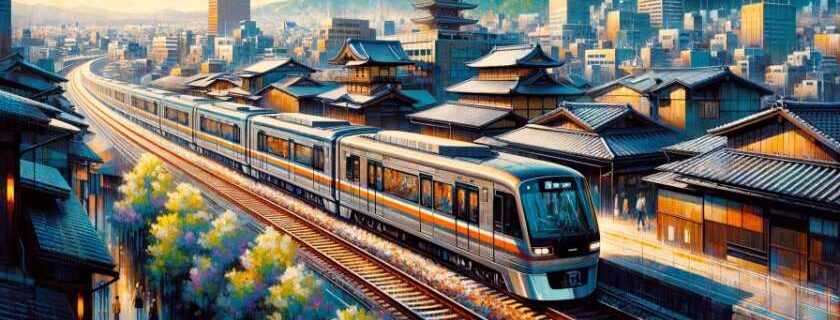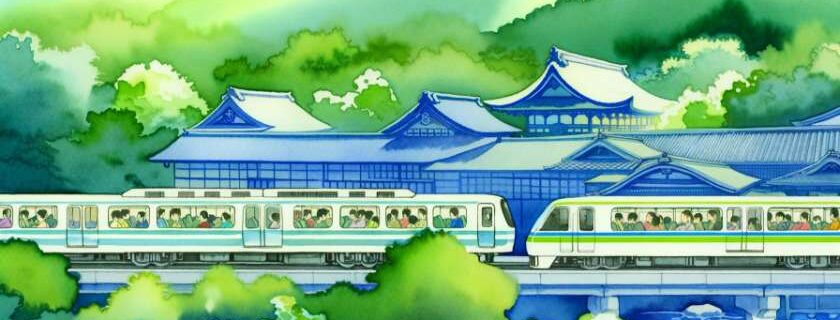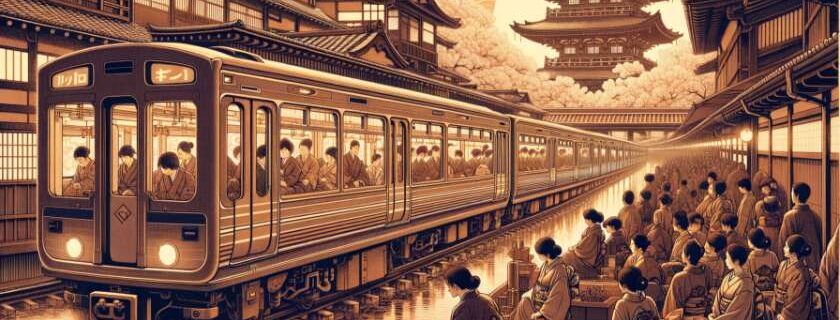
Navigating the bustling city of Kyoto can be a whirlwind experience, especially. From the serene beauty of Arashiyama to the vibrant streets of Gion, exploring Kyoto’s diverse neighborhoods is a must for any traveler. However, amidst the chaos of rush hour crowds and intricate train schedules lies a hidden gem – the simplicity and convenience of Kyoto’s trains. Unlike Tokyo’s labyrinthine subway system[1], Kyoto offers a more manageable yet equally effective way to traverse this historic city with ease.
Whether you’re visiting temples or sampling local delicacies in Nishiki Market, hopping on Kyoto trains is like embarking on a stress-free journey through time and tradition. Discover how these sleek trains effortlessly blend modern efficiency with ancient charm as you uncover the secrets of traveling like a local in this enchanting city.
- Key Takeaways
- Kyoto Trains Overview
- Kyoto Station Guide
- Shinkansen and JR Lines
- Private and Local Lines
- Specialty Train Journeys
- Sightseeing by Train
- Kyoto Metro System
- Alternative Transportation
- Traveling to and from Kyoto
- Final Remarks
- Frequently Asked Questions
- Is the Kyoto Metro System easy to navigate for tourists?
- How can I travel to and from Kyoto using alternative transportation methods?
- What are some specialty train journeys available in Kyoto?
- Are there any must-see sights accessible by train within Kyoto?
- How does one differentiate between Shinkansen (Bullet Trains) and JR Lines when traveling around Kyoto?
Key Takeaways
- Utilize the extensive train network in Kyoto for efficient and convenient travel around the city and to nearby attractions.
- Familiarize yourself with Kyoto Station and the different train lines to plan your journeys effectively and avoid confusion.
- Consider unique specialty train journeys for a more memorable and scenic travel experience in Kyoto.
- Opt for sightseeing by train to access various tourist spots easily and enjoy the picturesque views along the way.
- Make use of the Kyoto Metro System for quick and reliable transportation within the city center.
- Explore alternative transportation options to and from Kyoto for a diverse travel experience.

Kyoto Trains Overview
Train Routes
Kyoto boasts an extensive train network that efficiently links major tourist spots. The routes cover urban and rural areas, offering convenient travel options for exploring the city and its surroundings. For instance, visitors can easily hop on a train to reach iconic sites like Fushimi Inari Shrine or Arashiyama Bamboo Grove.
- Pros:
- Convenient transportation options
- Easy access to major attractions
- Cons:
- Possible crowded trains during peak hours
Subway Guide
The Kyoto subway system comprises two lines, simplifying navigation throughout the city for both locals and tourists. This mode of transport is favored for its efficiency in reaching various destinations within Kyoto. Travelers can refer to the subway guide for details on fares, schedules, and station locations before embarking on their journey.
- Key Information:
- Popular among locals and tourists alike
- Provides essential information for seamless travel
Station Maps play a crucial role in helping travelers navigate Kyoto’s train stations effectively by providing detailed layouts showcasing platform locations, exits, and nearby facilities such as convenience stores or ticket counters. These maps are readily available online or at the stations themselves, ensuring easy access to vital information needed during travels around Kyoto.
- Look out for station maps near entrances.
- Utilize online resources for virtual station tours.
- Station maps offer guidance even if you don’t speak Japanese.
Japan Rail Pass
The Japan Rail Pass, renowned among travelers visiting Japan including Kyoto, allows unlimited rides on JR trains encompassing Shinkansen (bullet trains). It presents excellent value particularly if planning extensive exploration across multiple cities in Japan as it covers not only local trains but also high-speed services.
Kyoto Station Guide
Buying Tickets
When traveling around Kyoto by train, purchasing tickets can be done at ticket counters or vending machines in the stations. It’s essential to check the fare and destination before buying to avoid any confusion later on. Some trains accept payment through IC cards, providing travelers with a more convenient payment option.
- Pros:
- Convenient ticket purchase options
- IC card payment for added ease
- Cons:
- Need to verify fare and destination beforehand
Hotels Nearby
Numerous hotels are strategically positioned near Kyoto train stations, offering easy access to transportation hubs. Opting to stay close to a train station allows visitors the convenience of exploring various parts of the city without much hassle. These hotels cater to all budgets, ensuring there’s accommodation suitable for every traveler.
- Key Information:
- Easy access to transportation
- Diverse accommodation options are available
Transportation Options
Apart from trains, Kyoto boasts an array of transportation choices like buses, taxis, and bicycles. Understanding these different modes of transport enables tourists to plan their itinerary effectively based on factors such as distance covered, time constraints, and personal preferences.
- Considerations when choosing transportation:
- Distance between locations.
- Time constraints during travel.
- Personal preferences regarding comfort and convenience.
Shinkansen and JR Lines
Navigating JR
The JR trains in Kyoto are color-coded, simplifying the process of finding the right platform and train. Station maps and signage assist passengers in navigating the extensive Japan Railways system efficiently. Timetables can be accessed both online and at stations, aiding travelers in planning their journeys conveniently. For instance, if you’re exploring historical sites like Nijo Castle, taking a JR train could be an ideal mode of transportation.
When boarding a JR train in Kyoto, look out for the color-coded lines to ensure you’re on the correct route. The clear signage at stations guides passengers seamlessly through transfers and connections within Kyoto or to neighboring cities like Osaka or Nara. Utilizing station maps helps travelers pinpoint their current location and decide on their next destination easily.
- Pros:
- Color-coded trains for easy identification
- Accessible timetables for convenient trip planning
- Cons:
- Can get crowded during peak hours
- Limited seating availability on some routes
Shinkansen Lines
Kyoto boasts multiple Shinkansen lines, connecting it swiftly with major cities such as Tokyo and Osaka. The high-speed nature of Shinkansen trains makes them a preferred choice for long-distance travel among locals and tourists alike. Besides providing rapid transport, riding the Shinkansen offers breathtaking views of Japan’s picturesque countryside landscapes.
Embarking on a journey via the Shinkansen from Kyoto opens up opportunities to explore various regions across Japan efficiently while relishing panoramic vistas along the way. Whether you’re heading to bustling urban hubs like Tokyo or serene coastal areas near Hiroshima, traveling by Shinkansen ensures not just speed but also scenic delights throughout your voyage.
- Steps to Navigate JR Trains:
- Check color-coded lines.
- Refer to station maps.
- Use online timetables for planning.
- Advantages of Riding Shinkansen:
- Swift connectivity between major cities. 2.. Enjoy stunning countryside views en route.

Private and Local Lines
Keihan Line
The Keihan Line connects Kyoto to Osaka and other cities, making it a vital transportation link for exploring the region. With frequent services all day long, it offers convenience for travelers looking to visit both Kyoto and its neighboring areas. For those wanting to experience the bustling city life of Osaka or explore beyond Kyoto’s borders, the Keihan Line presents an efficient and accessible option.
- Pros:
- Convenient access to multiple cities
- Frequent services throughout the day
Hankyu Line
Another essential private railway line is the Hankyu Line, connecting Kyoto with Osaka and Kobe. This line caters to both commuters and tourists seeking swift travel between these major cities. Offering various train types such as limited express and rapid services, the Hankyu Line ensures passengers can choose between speedier journeys or more leisurely rides based on their preferences.
- Pros:
- Efficient transportation for commuters
- Different types of trains available
Kintetsu Line
For travelers interested in exploring Nara’s renowned attractions from Kyoto, the Kintetsu Line provides a seamless connection. Ideal for day trips to delve into Nara’s cultural heritage sites, this line operates at regular intervals ensuring ease of travel for visitors. Whether it’s admiring ancient temples or strolling through serene gardens in Nara, the Kintetsu Line serves as a gateway to enriching experiences just a train ride away.
- Pros:
- Easy access to Nara from Kyoto
- Regular intervals for convenient travel
Eizan Line
The Eizan Line stands out as a scenic mountain railway taking passengers on enchanting journeys towards destinations like Kurama and Kibune. Offering picturesque views of rural landscapes along with charming vistas during cherry blossom season, this line promises travelers a unique travel experience immersed in natural beauty. If you’re yearning for an escape from urban settings into tranquil surroundings filled with awe-inspiring sights, hop aboard the Eizan Line for an unforgettable adventure.
Specialty Train Journeys
Kyo-Train Garaku
Kyo-Train Garaku stands out as a luxurious sightseeing train in Kyoto, providing passengers with a unique travel experience. The train’s elegant interiors create an atmosphere of sophistication and comfort for travelers to enjoy during their journey. With panoramic windows, passengers can marvel at the breathtaking views of Kyoto’s beautiful countryside while onboard.
One of the highlights of Kyo-Train Garaku is its gourmet dining options available on board, allowing passengers to indulge in delicious meals while immersing themselves in the scenic beauty passing by outside. This specialty train takes travelers on a leisurely ride through picturesque landscapes, offering a serene escape from the hustle and bustle of city life.
Sagano Romantic Train
The Sagano Romantic Train has captured the hearts of many visitors to Kyoto with its nostalgic charm and scenic route along the Hozu River. As one of Kyoto’s popular tourist attractions, this train ride offers passengers an opportunity to immerse themselves in nature’s beauty while experiencing stunning views along the way.
Passengers aboard the Sagano Romantic Train are treated to captivating sights of seasonal landscapes, making it especially renowned for its vibrant autumn foliage display that attracts tourists from far and wide. The gentle sway of the train as it meanders through valleys adds to the overall romantic ambiance experienced by those on board.
Sightseeing by Train
Recommended Spots
Kyoto boasts a plethora of recommended spots for tourists to explore, such as historical sites, temples, and gardens. Some must-visit locations in Kyoto include Kinkaku-ji (Golden Pavilion), Fushimi Inari Shrine, and Arashiyama Bamboo Grove. By hopping on the trains in Kyoto, visitors can efficiently cover multiple attractions during their stay.
Exploring these recommended spots by train is not only convenient but also allows travelers to appreciate the diverse beauty of Kyoto effortlessly. For instance, taking a train to the iconic Fushimi Inari Shrine enables visitors to immerse themselves in the vibrant culture and spirituality of Japan while enjoying a scenic journey along the way.
- Efficient way to cover multiple attractions
- Convenience of exploring various locations
- Immersive cultural experiences while traveling
Sightseeing Trains
Kyoto offers an array of sightseeing trains, each designed with unique themes that provide tourists with unforgettable experiences during their travels. These specialized trains offer scenic routes that showcase the natural beauty and charm of Kyoto’s landscapes. They often feature comfortable seating arrangements and informative audio guides for passengers’ convenience.
Embarking on one of these sightseeing trains allows travelers to witness breathtaking views while indulging in a relaxing journey through picturesque surroundings. For example, riding on the Sagano Romantic Train provides passengers with an enchanting ride through lush forests and alongside serene rivers—a truly magical experience that encapsulates Kyoto’s tranquility.

Kyoto Metro System
Metro Overview
The Kyoto metro system comprises the Karasuma Line and the Tozai Line, serving as vital arteries in the city’s transportation network. These lines efficiently connect tourists to major attractions, such as Fushimi Inari Shrine and Nijo Castle. Operating from early morning until late at night, these subways offer a convenient mode of transport for visitors exploring the city. With detailed information on fares, operating hours, and station facilities available both online and at stations, navigating Kyoto via its metro system is straightforward.
When traveling around Kyoto, utilizing the metro can be a cost-effective option due to its extensive coverage of key tourist spots like Arashiyama Bamboo Grove or Kinkaku-ji Temple. The efficiency of this transportation method allows visitors to maximize their time experiencing various cultural landmarks without worrying about traffic congestion or parking availability. Moreover, by purchasing passes or tickets beforehand either online or at designated locations within Kyoto, travelers can seamlessly access unlimited rides on trains, subways, and buses during their stay.
Passes and Tickets
Exploring Kyoto becomes more accessible with an array of passes tailored to suit different travel needs within the city. Tourists can opt for daily passes offering unlimited rides on specified modes of transportation or choose comprehensive options that cover multiple days for extensive sightseeing adventures across various attractions in Kyoto. By obtaining these passes before embarking on their journey through official channels like authorized vendors or online platforms dedicated to tourism in Japan ensures a hassle-free experience upon arrival in the city.
Alternative Transportation
Bus Services
Kyoto boasts an extensive bus network that caters to both urban and suburban areas. Buses are a favored mode of transport for tourists exploring the city’s attractions due to their convenience and accessibility. These buses run on regular schedules, making it easy for visitors to plan their journeys efficiently. Moreover, bus services in Kyoto offer route information in multiple languages, ensuring that travelers can navigate the city with ease.
When visiting Kyoto, opting for bus transportation is advantageous as it allows you to cover various destinations without worrying about navigating unfamiliar streets or dealing with parking concerns. Bus stops are strategically located near popular tourist spots and key locations, facilitating seamless travel experiences for visitors exploring the culturally rich city.
- Pros:
- Extensive network covering urban and suburban areas
- Regular schedules for convenient travel planning
- Multilingual route information enhances accessibility
Taxi Services
For those seeking a more personalized or direct mode of transportation in Kyoto, taxis present a convenient option. Taxis are readily available throughout the city and provide a comfortable way to move around, especially if you’re traveling in groups or carrying heavy luggage. Travelers can hail taxis on the street or locate them at designated taxi stands conveniently situated across Kyoto.
Choosing taxi services while touring Kyoto offers flexibility and comfort during your sightseeing adventures. With drivers familiar with local routes and destinations, you can reach your desired locations swiftly without having to worry about language barriers or deciphering complex public transportation maps.
Traveling to and from Kyoto
Kansai Airport Travel
Kansai International Airport stands as the primary gateway for travelers heading to Kyoto and the wider Kansai region. Upon arrival, visitors can select from various transportation options like trains or buses to reach Kyoto conveniently. For a seamless transfer, travelers have the choice of direct train services or airport shuttles that ensure swift journeys.
One significant advantage of utilizing direct train services is the time efficiency they offer. These trains provide a quick and straightforward mode of travel, allowing passengers to reach Kyoto promptly after their flight lands at Kansai International Airport. On the other hand, airport shuttles cater to those seeking a more relaxed journey with additional amenities onboard.
Bus Terminals
In Kyoto, several bus terminals operate as vital transportation hubs within the city’s infrastructure network. These terminals play a crucial role in connecting different parts of Kyoto and nearby regions efficiently. Equipped with essential facilities such as ticket counters, waiting areas, and information desks, bus terminals serve as convenient points for travelers looking to navigate around Kyoto seamlessly.
The convenience offered by bus terminals lies in their extensive coverage across various locations within Kyoto. Passengers can easily access different attractions or neighborhoods by utilizing these well-connected bus networks throughout the city. Bus terminals provide an excellent opportunity for tourists to explore neighboring regions outside of Kyoto without facing any logistical challenges.

Final Remarks
You’ve now got the lowdown on navigating Kyoto’s varied train systems, from the hustle and bustle of Kyoto Station to the serene rides on specialty trains. Whether you’re heading to historic sites or exploring hidden gems, trains are your ticket to seamless travel in this vibrant city. Remember, understanding the different lines and systems will make your Kyoto adventures smoother than a fresh jar of peanut butter.
So, hop on board, embrace the train culture, and let the rhythmic clatter of the tracks guide you through Kyoto’s wonders. Your next journey awaits—full steam ahead!
Frequently Asked Questions
Is the Kyoto Metro System easy to navigate for tourists?
The Kyoto Metro System is tourist-friendly with clear signs in English, maps at stations, and announcements in multiple languages. It’s efficient and connects major attractions, making it convenient for visitors exploring the city.
How can I travel to and from Kyoto using alternative transportation methods?
In addition to trains, you can explore Kyoto using buses, taxis, bicycles, or even walking. Buses cover areas not served by trains, taxis offer door-to-door convenience, cycling provides flexibility in sightseeing pace while walking lets you immerse yourself in the local culture.
What are some specialty train journeys available in Kyoto?
Kyoto offers unique train experiences like Sagano Scenic Railway or the romantic Sagano Romantic Train that take you through picturesque landscapes. These specialty trains provide a memorable way to enjoy the beauty of nature while traveling around Kyoto.
Are there any must-see sights accessible by train within Kyoto?
Several iconic landmarks like Fushimi Inari Shrine and Arashiyama Bamboo Grove are easily reachable by train. Trains offer a convenient way to visit these popular attractions without worrying about traffic or parking hassles often encountered when driving.
How does one differentiate between Shinkansen (Bullet Trains) and JR Lines when traveling around Kyoto?
Shinkansen refers specifically to Japan’s high-speed bullet trains connecting major cities swiftly. On the other hand, JR Lines encompass various conventional rail services covering both urban and rural areas within Japan including those serving destinations within Kyoto itself.




